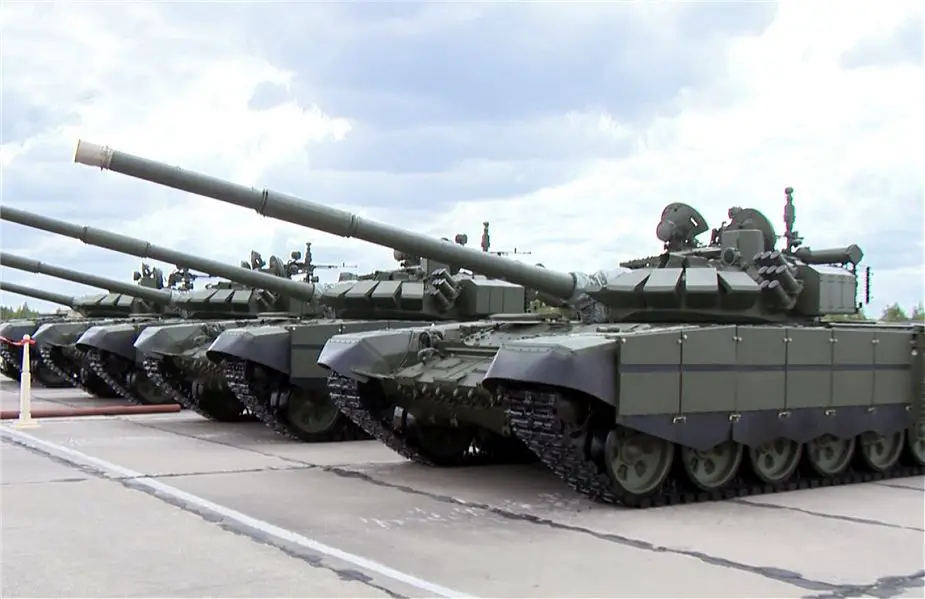According to Ukrinform on October 12, the military-industrial complex of Belarus is already involved in the repair of Russian equipment damaged during hostilities. In addition, the first batch of twenty T-72B tanks was removed from storage and sent to Russia’s Belgorod region, as stated in the report of the General Staff of the Armed Forces of Ukraine as of 06:00, October 12, posted on Facebook.
Follow Army Recognition on Google News at this link

Belarus T-72B3 main battle tanks (Picture source: Belarus MoD)
In June 2019, the Belarusian ministry of Defense signed a contract with the Russian tank manufacturer Uralvagonzavod Research and Production Corporation to modernize 11 T-72B main battle tanks to the level of T-72B3 in 2019-2020. More may have followed. Uralvagonzavod has been successfully upgrading T-72B tanks for the Belarusian army since 2015 under the Treaty on the Development of Military-Technical Cooperation between Belarus and Russia.
The T-72B3 is a development of the standard Russian-made T-72B series currently in service in the Russian army. The T-72B3 version was introduced in 2010 and is considered a third-generation of Russian main battle tank. The T-72B3 has significantly improved its combat characteristics with more firepower, protection, mobility and command controllability. Besides the improved armor and targeting systems, it kept all the good features of previous versions of T-72.
The main armament of the T-72B3 is a 125mm 2A46M-5 smoothbore gun fitted with a light-alloy thermal sleeve and a bore evacuator. The tank is fitted with a carousel automatic loader mounted on the turret floor and also on the rear wall of the turret. The tank carries a total of 38 rounds including 22 ready-use projectiles in the carousel. A 7.62 mm PKTM machine gun is mounted coaxially to the right of the main armament and one 12.7 mm NSV machine gun is mounted on the commander's cupola.
As Ukrinform writes, the Russians continue shelling the Ukrainian positions along the contact line, remotely mine the territory in certain areas, conduct aerial reconnaissance, attack civilian infrastructure and houses, violating international humanitarian law, laws and customs of war. Over the past day, the occupiers launched 1 ballistic and 28 cruise missiles, 20 of which were shot down by the Ukrainian air defense units.
The enemy launched 13 airstrikes and more than 40 MLRS attacks. The civilian population and facilities of more than 40 settlements, including Lviv, Popivka, Chuhunivka, Ladyzhyn, Kryvyi Rih, Zaporizhzhia, Pavlohrad, and Nikopol, were affected. Moreover, the enemy used 14 Iranian kamikaze drones to attack critical infrastructure in Odesa and Mykolaiv regions. 12 of these UAVs were destroyed. There is a threat of airstrikes and missile strikes on the entire territory of Ukraine.
Over the past day, the Ukrainian troops repelled the occupiers’ attacks near Mykolaivka, Soledar, Bakhmutske, Bakhmut, Mayorsk, Pervomaiske, and Krasnohorivka.
The Ukrainian aviation launched 15 strikes during the day. Thirteen areas of enemy weapons and military equipment build-up, as well as two enemy air defense systems, were damaged. The Ukrainian missile and artillery units hit 12 Russian command posts, 17 areas of manpower, weapons and military equipment build-up, four ammunition depots, as well as more than twenty other important enemy facilities, Ukrinform reports.
Russian mobilized reservists train operating drones
MOSCOW, October 13. /TASS-DEFENSE/. The Russian Defense Ministry released a video of training of mobilized reservists in the rear of the Ukrainian operation. They engage drones for reconnaissance and fire adjustment.
“The mobilized reservists train tactical skills, offensive and defensive combat, as well as medical aid. They study controlling drones in reconnaissance and artillery fire adjustment,” the ministry said.
Mobilized drivers restore skills to drive tracked and wheeled vehicles. “They no longer fear their own weapons and train cohesion. We pay attention to movement in the battlefield, medical and engineering skills,” an instructor with Stavropol call sign said.
The reservists will guard the liberated territories and operate as reserve and reinforcements.














